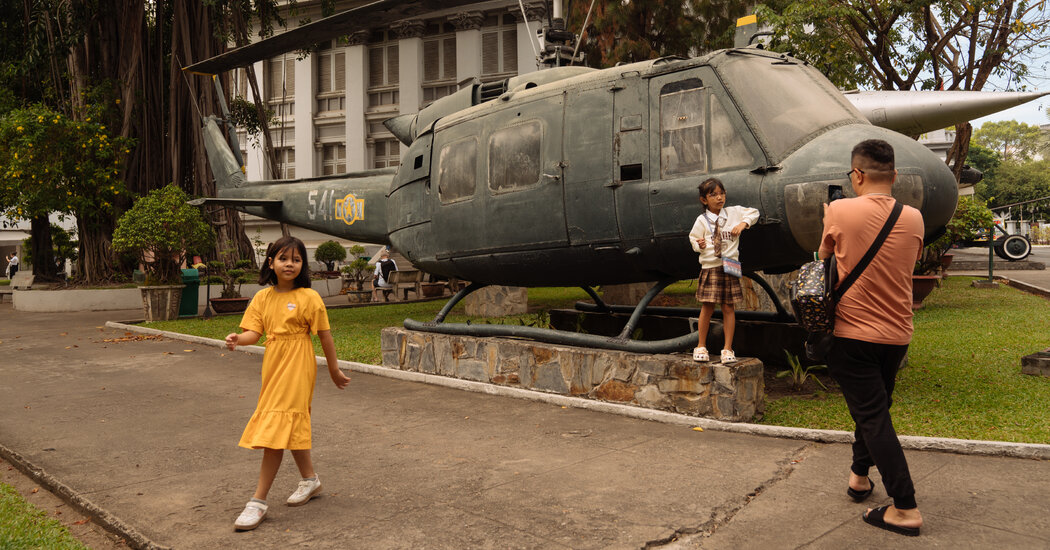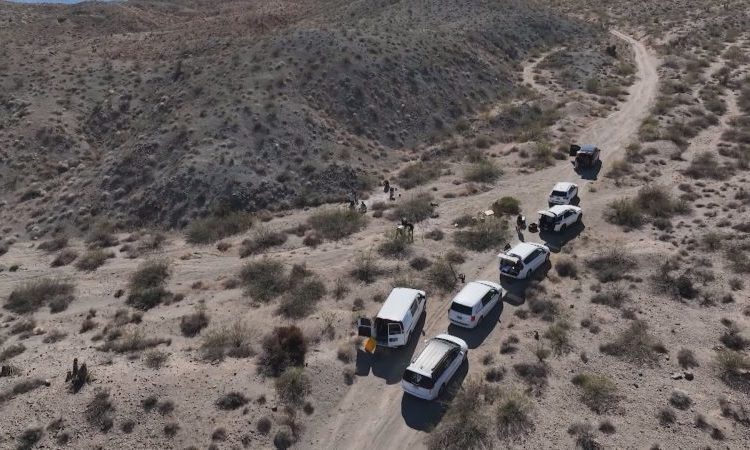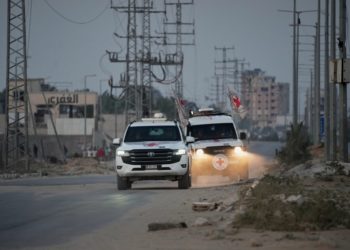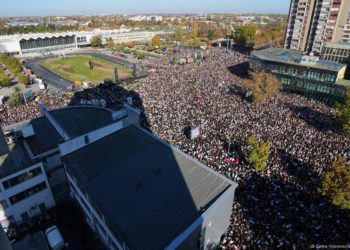On April 30, 1975, Vu Dang Toan commanded the first tank to smash through the main gate of Saigon’s Independence Palace. After seeing so many die — after grinding away his youth battling the Americans and the forces of South Vietnam — he was there, alive and surprised, for the war’s weary end.
It was a full surrender. At the United States Embassy nearby, helicopters had already carried away the last Americans as the South’s fighters disappeared, ditching their uniforms and boots in the streets.
“I’m proud,” Mr. Toan said, “that as a soldier, I completed the mission.”
Fifty years later, he was a long way from that moment, sitting in his comfortable home north of Hanoi, encircled by rice fields, not far from factories pumping out Apple Watches.
Photos on the wall showed his tank on the palace lawn. Wearing his military uniform, he sipped tea in a dark wood chair beside his grandson Dang Hoang Anh, 14, a bright-eyed soccer fan wearing a school uniform in Chelsea blue.
The boy pictured his life in different terms.
His goal? “To study in Canada.”
His mission? “To make money.”
“My grandparents’ generation, they had to go to war and people died,” Hoang Anh said. “Now we don’t worry about that. We worry about school and jobs.”
The Vietnam War was many things: a nationalist uprising against colonization, a killing machine that took the lives of at least one million Vietnamese and 58,000 American servicemen, and a civil war in Asia that tore America apart. But it was also a bloody conflict over economic systems and cultures — the North’s revolutionary socialism versus the South’s freewheeling market scramble.
A half-century later, ideology is mostly dead and pragmatism is thriving. Vietnam has moved in a single lifetime from war to peace, rural to increasingly urban, poor to roughly middle-class, and explicitly Communist to a complex hybrid of free markets and state control.
Major multinationals (Nike, Samsung, Apple and others) have made Vietnam an export hub. The country, which liberalized its economy in the late 1980s, has been pushing toward higher-tech manufacturing and income levels closer to those of richer nations in Asia.
But the Vietnam model — mixing youthful workers, massive factories, flexible diplomacy and open markets for its exports — now faces a more hostile world.
The U.S.-China trade war is injecting uncertainty into a system that has hugely benefited Vietnam, freezing investment and slashing projections of economic growth. And the disruption comes at a terrible time — in the last decade of Vietnam’s “demographic dividend,” before the population rapidly ages.
And yet, for a resilient nation that is more windshield than rearview mirror, hope is always just up the road. Vietnam regularly tops rankings of the most optimistic countries, and according to many Vietnamese, it’s for good reason.
As recently as the 1990s, most were poor. Now less than 4 percent of the population lives below what the World Bank considers the national poverty line, earning less than $3.65 a day. Per capita annual income has jumped more than sixfold, to roughly $4,500, since 2000 — and everyone who can seems eager to join the world’s social media stream, whether it’s with fashion, food or hip-hop.
Nothing defines Vietnam more right now than the desire to be seen anew, to have Vietnam and its people recognized for their strengths. That urge has produced a potent and paternalistic nationalism. Factional struggles in the ruling elite sometimes open space for targeted critiques (of corruption, for example). But mild questioning of the system in art, books, religion and online still draws police repression.
Ambition is the focal point, for the government, too. Communist Party leaders recently launched a bold plan to consolidate provinces, merge ministries and cut the public work force by a third.
The goal is to move fast, and that drive for achievement is especially visible in classrooms.
At the Tan Phu Secondary School in Ho Chi Minh City, a private school that is part of a for-profit network emphasizing global citizenship, the physics club is especially popular.
The school day runs from 7:20 a.m. to 4:50 p.m. The stairs display quotes in English like “leadership is a choice not a position.”
A decade ago, Tan Phu was one of just a few private schools in the district. Now there are 58. And all over Vietnam, bright high schoolers are pushing for, and expecting, upward mobility.
The students at Tan Phu are mostly the offspring of shop owners, office workers or factory managers. Ask these teenagers what they want, and nearly all will say studying abroad. Many pull it off.
In 2000, Vietnam sent around 1,300 students to further their education in the United States; last year, American universities welcomed 22,000. Another 37,000 or so studied in Australia.
Why is an international education so important in Vietnam?
It’s not just “to make money.” In interviews with parents and teachers, something deeper emerged — the lingering impact of war and the struggles that followed.
The decade after 1975 was a desperate time of food shortages and suspicion. Soviet-style planning paralyzed the economy, while the North’s leaders sent hundreds of thousands from the South to re-education camps, blacklisting them from government jobs and banning their children from universities. More than a million Vietnamese fled on boats in the 1970s and early ’80s.
For those who recall that era, the opportunities of the present feel profound — and they must be seized, as if they offer a way to paint over one Vietnam with another. The postwar generations have something to prove: that their homeland is much more than war and refugees.
“Vietnam can get along with all the other developed nations,” said Le Tra My, 39, Tan Phu’s vice principal and a mother of three. “We want to show them the capabilities of the Vietnamese people.”
In Vietnam’s big cities, smog has reached crisis levels. Many days this year, Hanoi has topped the rankings of the world’s most polluted cities, and Ho Chi Minh City has not been far behind.
Call it the cough of Vietnam’s boundless growth. Coal generates more than half of the country’s electricity during peak demand. When farmers were given more freedom to grow for the market, they produced wild abundance with copious quantities of fertilizer and pesticides.
Especially for the Mekong, all of this has combined with climate change to threaten one of the planet’s most productive regions for food and fishing.
Le Hoang Phuc, 25, grew up on a family farm deep in the south. It had been abandoned during the war when Saigon’s leaders relocated rural residents into so-called strategic hamlets. When Mr. Phuc moved back as a boy, he could cup his hands in the shimmering water of nearby streams and watch fish squirm through his fingertips.
“Today we have more trash than fish,” he said.
Sitting near hives of bees making honey on a recent afternoon, he told us that his legs burned from chemicals when he stood in the dirtiest canals.
In TikTok and YouTube videos, Mr. Phuc has been filming himself explaining the value of cleaner alternatives — like the organic farming that his family has now adopted.
They are doing their small part to keep the area healthy, while acknowledging it’s not enough.
He said the Mekong now needed stricter laws, and garbage trucks for rural areas. Even more important, he added, Vietnamese society needed to reclaim a community mind-set.
“People want to clean up their own houses,” he said. “They don’t care much about common spaces.”
Weekend retreats at the Giac Ngo Pagoda in Ho Chi Minh City are a bustling affair, now regularly attended by scores of young professionals, who chant together under the gaze of golden Buddhas.
They come for meditation, songs (some with electric guitars) and messages warning against consumerism.
“For many lifetimes, we have forgotten our true nature,” a monk told the group on a recent Sunday. “We are entangled in the world of delusion, intoxicated by greed and anger.”
The event was live-streamed on Facebook for those who couldn’t make it in person.
Catholic seminaries and convents across Vietnam have also expanded in recent years, producing a bumper crop of young priests and nuns.
As young men and women embrace faith — along with folk songs, traditional dress and ancient tea ceremonies — some experts see it as a movement back to forms of Vietnamese identity that preceded Marxism and war.
“Vietnamese culture is like an underground stream,” said Nguyen Duc Loc, an anthropologist who studies social change. “It’s hidden from the surface, yet always present, quietly nurturing everything around it.”
The government has mostly accepted the traditionalist revival.
The AO Show at the Opera House in Ho Chi Minh City, featuring modern dances with bamboo and folk songs, has become a hit for both tourists and local school groups. The performers see themselves as active participants in protecting Vietnam from foreign forces.
“The most important thing for me as a young person is to preserve the culture of Vietnamese people — beyond wars,” said Doan Khanh, 34, an AO Show dancer.
But expression in Vietnam has limits. This is still a one-party state where dissent can lead to prison.
Vietnam is not China, with its censored internet and sophisticated systems of heavy policing. It does have red lines that are real and sometimes hard to see, especially for cultural creators, nonprofits and the faithful outside institutional hierarchies.
“It’s a very challenging — yet inspiring and dynamic — environment,” said Quynh Pham, who fled Vietnam as a child and returned 28 years ago to research the contemporary arts scene.
In 2003, she co-founded Galerie Quynh, a contemporary art gallery in Ho Chi Minh City, which recently hosted a show of new work by Tuan Andrew Nguyen, a Vietnamese American artist. In a sign of past becoming present, and of what is allowed, the show included large mobiles reminiscent of childhood toys, with dragonflies made from old artillery shells, resting in perfect equilibrium.
That kind of balance — between openness and control — is proving hard for Vietnam to find.
In 2022, an art exhibition meant to commemorate Vietnam’s victory over the French at Dien Bien Phu was shut down by officials — apparently because a painting included images of a tattered flag and bony soldiers.
Even a devout Buddhist who went viral for his asceticism and long barefoot walks around the country was detained last June and forced to end his pilgrimage in Vietnam.
Because he had gained followers online and off, independent of the state-sponsored Buddhist system, he was treated as a threat.
My Dien is a hurried cluster that has grown up ad hoc, with buildings of varying sizes rising like reeds from a fertile swamp.
More than a decade into the town’s existence, the energy of neon mingles with the early decay of rushed construction.
Vietnam is young — with an average age of around 32 — but getting older as birthrates decline. Companies are having to venture further afield to find workers, which drives up costs in a time of intense international competition, and may hinder Vietnam’s future growth.
In 1946, Vietnam’s most famous revolutionary, Ho Chi Minh, told The New York Times that economic independence would be harder for Vietnam to obtain than political independence. And it’s still true.
The question for the 50 years ahead has become more urgent: What comes next?
Inside the dorms of My Dien, there are now more workers like Phan Van Du, who at 40 would have been considered too old for a factory job just a few years ago. When a recruiter showed up in his village in 2023, he said he immediately agreed to work with Foxconn, a major Apple supplier.
In a good month, working 7 p.m. to 5 a.m. with some extra shifts, he said he earned about 11 million dong, or $430, slightly more than the national average.
“For me, I think it’s been worth it,” he said. But he wants his 15-year-old son to aim higher.
“I hope he’ll study and do better and be an engineer, but it’s hard,” he said. “I don’t know if he’ll be able to do it.”
The hope, for many in Vietnam, is that the war and all its concomitant struggles will fade into the oblivion of prosperity.
Reconciliation with the United States has come, with ups and downs.
There’s been less of a reckoning internally. The narrative of revolutionary victory has stifled discussions about the pain of Vietnamese killing Vietnamese, and the cruelty that followed the North’s victory, with camps and discrimination.
In an essay published on Sunday, Vietnam’s top leader, To Lam, became the first party chief to acknowledge that national reconciliation could come only with “accepting different perspectives.” He said he was inspired by conversations with overseas Vietnamese, including those who “once belonged to the ‘other side.’”
The hard work of unification remains. Thousands of families from the North and South are still looking for the bodies of relatives lost in the war.
America’s military tactics linger. Nguyen Ngoc Phuong, 45, whose father was exposed to Agent Orange near Da Nang, leading him and his sister to be born with physical deformities, told us he wished more young people recognized that the war’s toll is never far — and that grit clears a path for dreams.
“Without yesterday, we don’t have today,” he said. “Without the suffering of people who endured the war, there’s no peace.”
Peace, however, is not just the absence of combat.
Phan Duong Hung Tam, 57, runs a business making women’s dresses for American brands. One of his factories is in Dong Nai Province, outside Ho Chi Minh City. In a recent visit, Mr. Tam told us that finding peace of mind was harder now as costs rose and orders shrank.
He said he’d grown up in Quang Tri, near the contested dividing line between North and South. His father was a senior military officer for the South in Da Nang near a U.S. base.
As a result, he said: “My life before ’75 was going pretty well. I was 6 or 7, and we wanted for nothing.”
After the war, his family moved around and struggled with being kept out of good jobs because of their Southern connections. In 1987, his father fled by boat, taking Mr. Tam’s siblings with him. He returned only in 2003, when he was ill and ready to die.
Mr. Tam sighed after recounting his family’s breakup and the switchbacks in fortune — which included success with an apparel boom 25 years ago, and a son studying dentistry.
As the sun set, we asked a final question: Do you feel better off than you did 50 years ago?
He leaned back in his chair. Sewing machines hummed. Tears formed in his eyes.
“Life is getting better,” he said. “It’s OK.”
Produced by Matej Leskovsek, Sean Catangui, Craig Allen and Gaia Tripoli
Damien Cave leads The Times’s new bureau in Ho Chi Minh City, Vietnam, covering shifts in power across Asia and the wider world.
Tung Ngo is a Times reporter and researcher based in Hanoi, Vietnam.
The post Vietnam
on the Move appeared first on New York Times.




